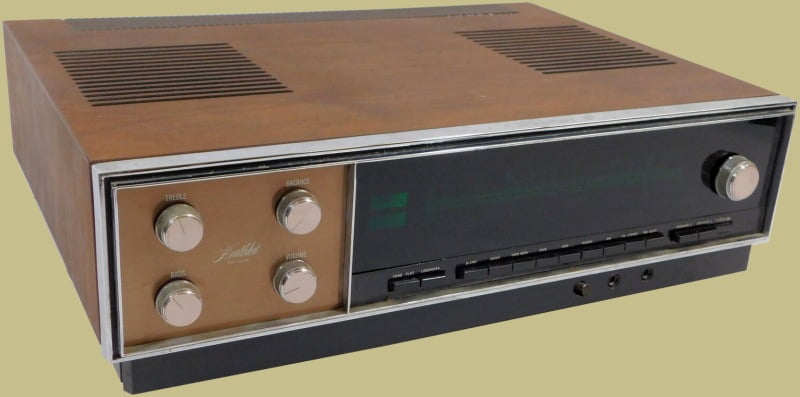
The Heathkit AR-1500 was unveiled circa 1972 as Heath’s flagship model following the renowned AR-15. It was offered in two options: a kit version and a pre-assembled version, with the kit priced at $379.95 and an additional $24.95 for the walnut cabinet. Fully assembled and with a walnut cabinet it retailed for $649.95 (ARW-1500). The introduction of the AR-1500 had a significant impact in the market. It provided a reliable and relatively powerful receiver with an exceptional tuner, all at a reasonable cost when purchased as a kit. Stereo Review magazine said it was easily worth twice the cost.
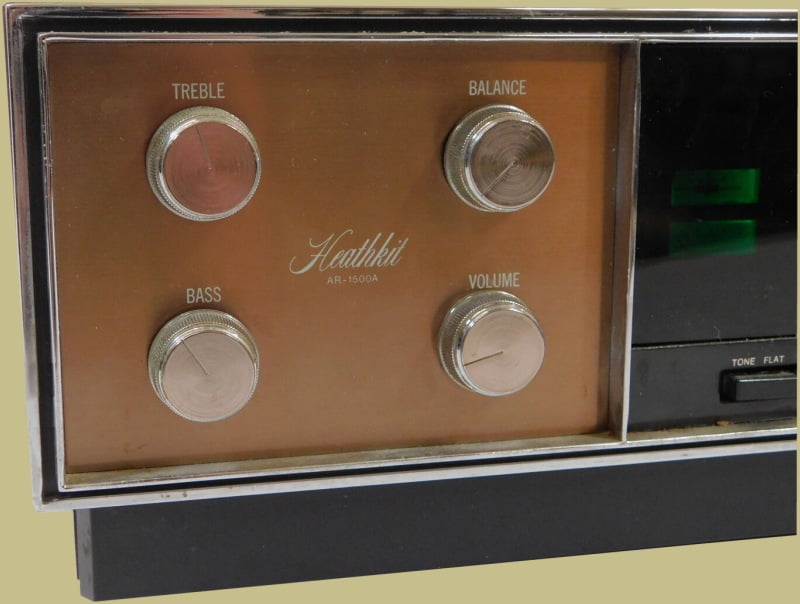
Some feel that the AR-1500 is unappealing aesthetically. This may be because of the long row of black function buttons under the dial face which gives it a table radio look. But, the optional walnut case (with elegant slotted vents on the top) combines nicely with the champagne color of the left side faceplate. It may not be what people picture in their minds when they think of silver faced vintage stereos but when powered on the AR-1500 has a nice look.
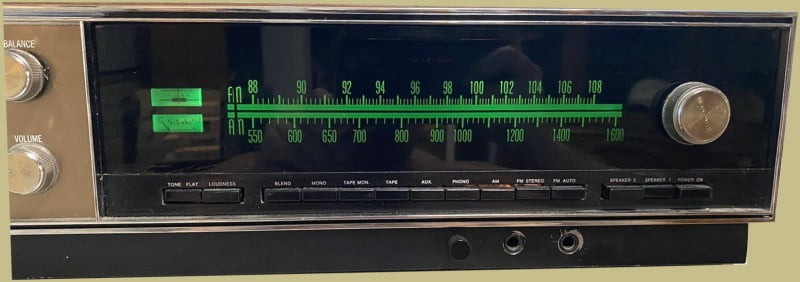

The dial can be somewhat dark even if all the bulbs work. There is a translucent diffuser behind the dial face that can be removed to brighten it up if desired. Or, maybe brighter LED replacements would work as well.
The AR-1500 produced 60 watts per channel into 8 ohms. This was quite a bit for the early 1970’s. In fact, in 1971 Stereo Review said of the AR-1500:
“The AR -1500 is the most powerful and sensitive receiver we have ever measured…”
They went on to say:
It significantly bettered Heath’s conservative specifications. Into 8-ohm loads, with both channels driven, the continuous power at clipping level was 81.5 watts per channel. Into 4 ohms it was 133 watts per channel.
Note: Not advisable to run 4 ohm speakers on the AR-1500 as it can overheat.
You’ll see some 90 wpc quotes around but that is for dynamic power output as opposed to continuous, which is usually how wpc is compared. With continuous power output it produces 60 watts into 8 ohms.
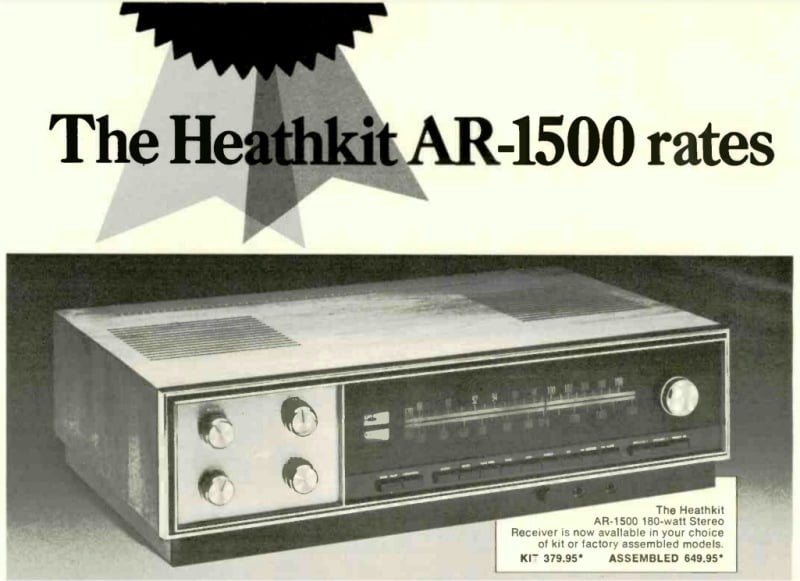
There was also a Heathkit AR-1500A (shown above) which came out in 1974 and is essentially the same as the AR-1500 but with an upgraded amplifier section. The AR-1500 had difficulty running 4 ohm speakers (which included AR’s own AR3a speakers) and tended to overheat, so Heath modified some of the circuitry in the AR-1500 to handle lower impedance and rebadged it as the AR-1500A. Visually they look the same and their is no difference in the sound between the two. The AR-1500A retailed for $399.95 plus $24.95 for an optional walnut cabinet (ARA-1500-1).
Here’s how Heathkit explained the new AR-1500A:
“The tradition of Heathkit stereo receiver superiority began in 1967 with the Heathkit AR-15. Then in 1971 came the AR-1500. Now, it’s the AR-1500A, the world’s classic receiver, improved once again. Design advancements include:
Phase Lock Loop (PLL) multiplex demodulator with only one simple adjustment. . .your assurance of maximum separation, drift-free performance and long-term stability. Simplification of the AGO circuit resulting in significant improvements in AM performance. Improved output protection for better drive capability over today’s wider range of speaker impedances.“

The boards inside the AR-1500 are modular, with the exception of the main preamp board, so they are easy to replace. You just have to find a good one first. In fact, virtually all the circuit boards plug into sockets, which are hinged so that boards can be swung out for testing or servicing without shutting off the receiver. An “extender” cable permits any part of the receiver to be operated in the clear – even the entire power transistor and heatsink assembly.
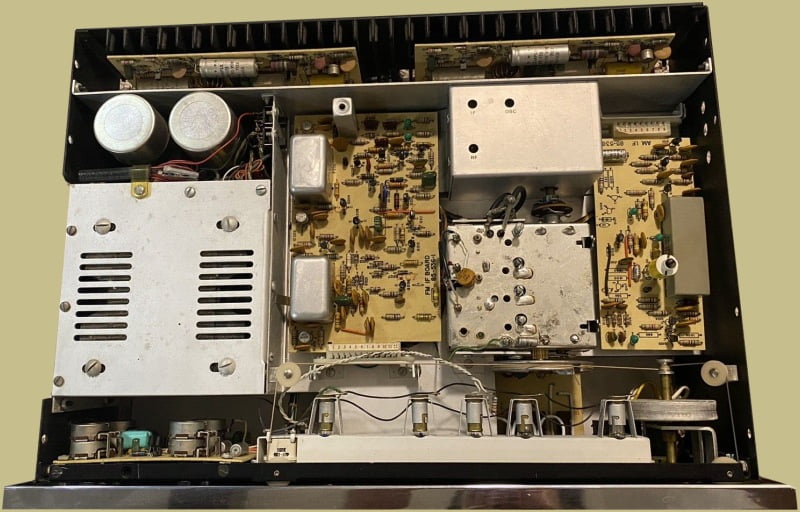
Of course, you have to keep in mind that many of these stereos were assembled by amateurs but, in general, they seem to hold up well. Nowadays most will need recapped and the AR-1500 can also be upgraded to the AR-1500A specs if desired. Restoration and upgrade kits can be found on eBay HERE.
The AM and FM sections in the AR-1500 are surprisingly good. In 1971, Audio Magazine said:
The FM tuner section of the AR -1500 was outstandingly sensitive. We measured the IHF sensitivity at 1.4 microvolts, and the limiting curve was the steepest we have ever measured. The FM frequency response was literally perfectly flat from 30 to 15,000 Hz. Image rejection was over 100 dB (our measuring limit). The AM tuner was a pleasant surprise…it sounded very much like the FM tuner, with distinct sibilants and a quiet background, and was easily the best sounding AM tuner we have had the pleasure of using.
The phono section isn’t bad either. Audio equipment evaluator, Julian Hirsch stated:
The phono equalization was perfectly accurate (within our measuring tolerances). The magnetic phono input sensitivity was adjustable from 0.62 millivolt to about 4.5 millivolts, with a noise level of — 66 dB, which is very low. When properly set up, it would be impossible to overload the phono inputs of the AR-1500 with any magnetic cartridge.
Look at that large power transformer!
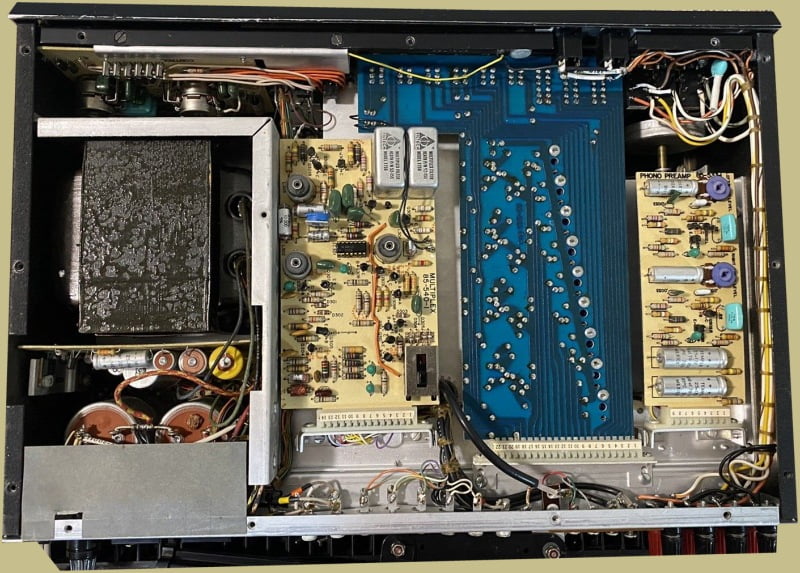
Typical problems with the AR-1500 include:
- The bulbs (or at least some of them) are almost always out. They aren’t too hard to replace though.
- The two large 6000uf power supply caps usually have issues as well. Of course, a recap would remedy that.
- The power switch is known to fail as well which isn’t such an easy fix.
- The FM circuit board is also commonly bad.
There are usually quite a few parts for the AR-1500 and AR-1500A on eBay. You can find what’s currently available HERE.
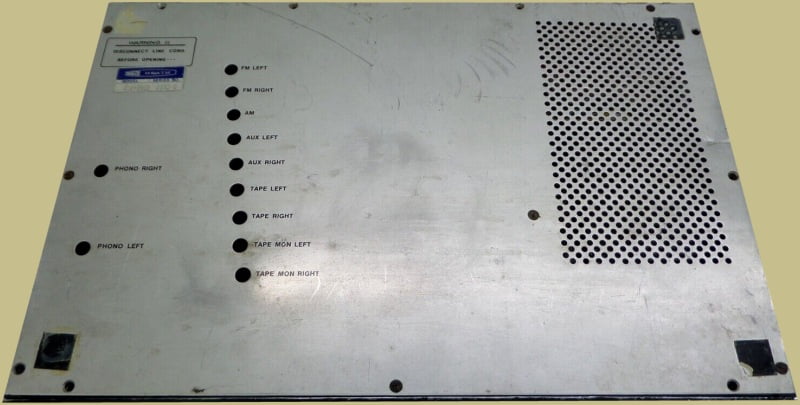
The AR-1500 is pretty heavy at 42 pounds (19kg) with the wood cabinet. It measures 181/2″ W x 51/8″ H x 137/8″ D. The kit, unassembled, weighed in at 53 pounds.

As you can see the back panel is dominated by a large heatsink. There are connections for two sets of speakers, AM and FM antennas (there is also an attached AM antenna) as well as inputs for a Phono, Aux, Tape, and Tape monitor. It has preamp out and power amp in connections as well. The Scope connection is for an oscilloscope that Heath sold as a kit and could be used to diagnose your AR-1500.
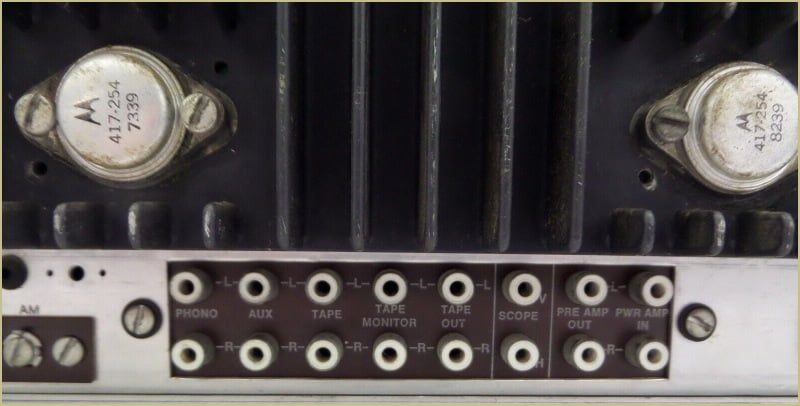
The Heathkit AR-1500 can be a great receiver especially if cleaned and recapped. They are easy to work on and parts are still obtainable. The AR-1500A would be the best choice as it doesn’t need upgraded like the AR-1500 might (if you want to run 4 ohm speakers). Also, the walnut cabinet, on either the AR-1500 or AR-1500A, really adds to the look of the stereo as without it it looks pretty bland.
Audio Magazine said:
In sound quality and ease of operation, and in overall suitability for its intended use, one could not expect more from any high-fidelity component.
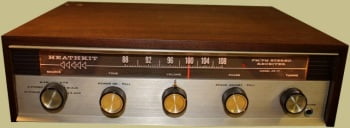
The E-42153 switch, available from both Amazon and ebay, is an exact replacement for the speaker switches, as well as the power switch on the AR-1500. It is relatively easy to replace. This switch is also used as the speaker switch on the AR-1500A, and can be used to replace the power switch on this unit, as well.
That replacement switch on Amazon has a round push button. Can it be replaced easily with the original AR-1500A black rectangular button?
Yes, the push button is easily removed, and replaced with the original AR-1500A rectangular button.